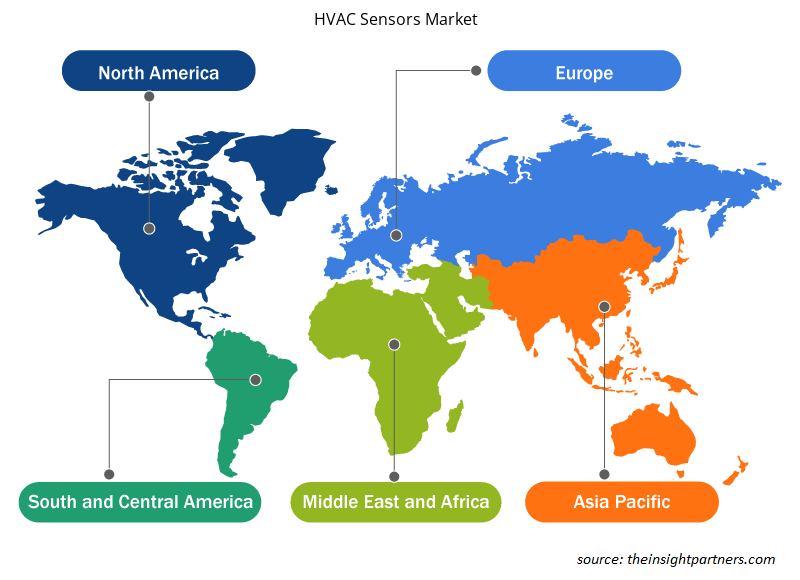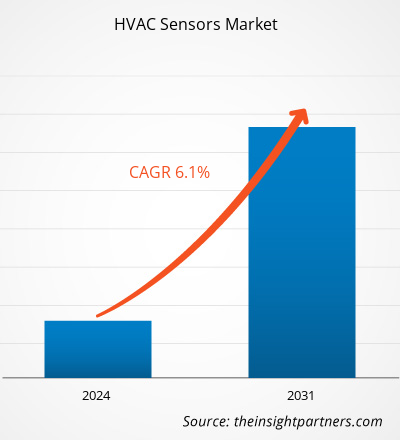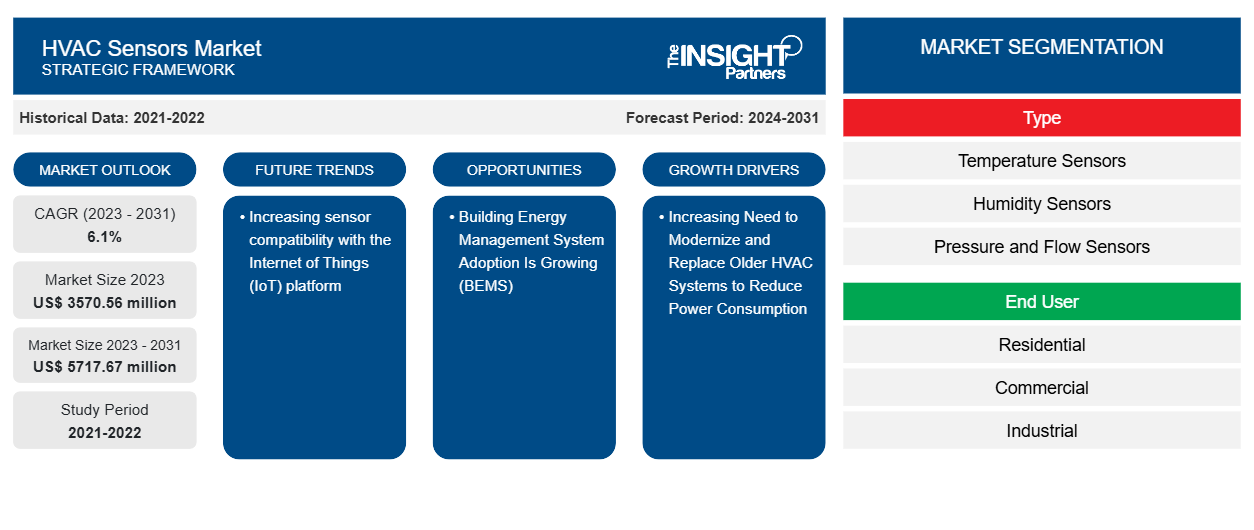HVAC センサー市場規模は、2023 年の 35 億 7,056 万米ドルから 2031 年には 57 億 1,767 万米ドルに達すると予測されています。市場は 2023 年から 2031 年にかけて 6.1% の CAGR を記録すると予想されています。
モノのインターネット (IoT) プラットフォームとのセンサーの互換性の向上は、今後も HVAC センサー市場の主要なトレンドであり続けると思われます。
HVACセンサー市場分析
HVAC センサー市場は、商業、住宅、自動車などのさまざまな業界で利用されています。現在、ビジネスの世界では、大手企業が環境保護、生産性、品質、安全性、安全性を優先する必要があるため、熾烈な競争が繰り広げられています。過去数年間、HVAC システムは世界中の多くのプログラムで広く使用されてきました。圧力センサーや温度センサーなど、多数のセンサーが、それらを可能にする用途を見つけています。HVAC システムは、車内と室内の両方に良好な空気質と温熱快適性を提供します。HVAC センサーは、エネルギー効率を気にするさまざまなエンドユーザーのニーズに対応するために使用されます。HVAC センサーは、低電力消費で適切に維持された室内空間の提供に役立ちます。
HVACセンサー市場の概要
HVAC システムは、エネルギー使用量の維持、制御、および削減に頻繁に使用されます。温度やターゲット環境などの実際の状態を模倣するオーディオ デバイスが周波数に含まれています。最も重要な種類の HVAC センサーは、入力温度と建物または室温を区別することで、適切な温度を維持し、必要な温度を調整するのに役立ちます。工業用、住宅用、商業用の建物を含むエンド ユーザーにとって、HVAC センサーは、空気圧、温度、品質などのさまざまな操作を管理、制御、および監視できます。その結果、エネルギーを節約する必要性から、HVAC センサーはますます一般的になっています。
要件に合わせてレポートをカスタマイズする
このレポートの一部、国レベルの分析、Excelデータパックなど、あらゆるレポートを無料でカスタマイズできます。また、スタートアップや大学向けのお得なオファーや割引もご利用いただけます。
-
このレポートの主要な市場動向を入手してください。この無料サンプルには、市場動向から見積もりや予測に至るまでのデータ分析が含まれます。
HVAC センサー市場の推進要因と機会
電力消費を削減するために、古い HVAC システムを近代化および交換する必要性が高まっています。
世界経済フォーラムは、建物がエネルギー関連の二酸化炭素排出量の 40% 以上を占め、世界のエネルギー消費のほぼ 3 分の 1 を占めていると推定しています。世界グリーンビルディング協会によると、これらの排出量の約 3 分の 1 は、建物の暖房、冷房、電力供給など、建物の運用に必要なエネルギーによって発生しています。Iota Communications によると、平均的なオフィスビルは年間約 3 万ドルの電気代を費やしています。商業施設では、HVAC システムが頻繁に最も多くのエネルギーを使用します。米国エネルギー省の推定によると、HVAC システムは通常、建物のエネルギー使用量の 35% を占めています。パンデミックの間、空気ろ過特性を備えた HVAC システムの必要性が高まりました。更新された換気システムは、空気をろ過し、ウイルスを含む粒子などの空気中の汚染物質を減らすことで、公衆衛生の重要な目的を果たします。
ビルエネルギー管理システム(BEMS)の導入が拡大
建物は、HVAC システムがなければ機能しません。その費用は莫大ですが。オーストラリア気候変動・エネルギー・環境・水省は、平均的な HVAC システムが建物全体のエネルギー消費量の約 40%、基本エネルギー使用量の 70% を使用していると推定しています。ビルエネルギー管理システム (BEMS) と呼ばれるコンピューターベースの自動化システムは、機械設備や電気設備など、建物内のすべてのエネルギー関連システムを監視および制御します。エネルギーシステムと供給の正確で自動化された制御を可能にすることで、エネルギー管理は企業を不必要なエネルギー支出から守ります。Radiocrafts によると、企業は BEMS の助けを借りて現在のエネルギー使用量を最大 10% から 30% 削減できます。ロシアとウクライナの紛争の結果、EU ではエネルギー価格が急騰しています。したがって、ビルエネルギー管理システム (BEMS) の採用は、予測期間中に HVAC プレーヤーに新たな機会をもたらすと予想されます。
HVAC レポートのセグメンテーション分析
HVAC 分析の導出に貢献した主要なセグメントは、タイプとエンド ユーザーです。
- タイプに基づいて、HVAC は温度センサー、湿度センサー、圧力および流量センサー、モーションセンサー、煙およびガスセンサー、その他に分類されます。温度センサーセグメントは 2023 年に大きな市場シェアを占めました。
エンドユーザーに基づいて、HVAC センサー市場は住宅用、商業用、産業用に分類されます。
HVACセンサーの地域別市場シェア分析
HVAC センサー市場レポートの地理的範囲は、主に北米、アジア太平洋、ヨーロッパ、中東およびアフリカ、南米/中南米の 5 つの地域に分かれています。商業ビル、工業施設、住宅など、現代的でよく発達したインフラが多数あるため、北米は HVAC センサーとコントローラーの最大の市場シェアを持っています。複雑な HVAC システムを備えた建物が多数あるため、HVAC センサーとコントローラーの市場はかなりの規模があります。
HVAC センサー市場の地域別分析
予測期間を通じて HVAC センサー市場に影響を与える地域的な傾向と要因は、Insight Partners のアナリストによって徹底的に説明されています。このセクションでは、北米、ヨーロッパ、アジア太平洋、中東およびアフリカ、南米および中米にわたる HVAC センサー市場のセグメントと地理についても説明します。

- HVACセンサー市場の地域別データを入手
HVACセンサー市場レポートの範囲
| レポート属性 | 詳細 |
|---|---|
| 2023年の市場規模 | 35億7,056万ドル |
| 2031年までの市場規模 | 57億1,767万ドル |
| 世界のCAGR(2023年~2031年) | 6.1% |
| 履歴データ | 2021-2022 |
| 予測期間 | 2024-2031 |
| 対象セグメント |
タイプ別
|
| 対象地域と国 |
北米
|
| 市場リーダーと主要企業プロフィール |
|
HVAC センサー市場のプレーヤー密度: ビジネスダイナミクスへの影響を理解する
HVAC センサー市場は、消費者の嗜好の変化、技術の進歩、製品の利点に対する認識の高まりなどの要因により、エンドユーザーの需要が高まり、急速に成長しています。需要が高まるにつれて、企業は提供を拡大し、消費者のニーズを満たすために革新し、新たなトレンドを活用し、市場の成長をさらに促進しています。
市場プレーヤー密度とは、特定の市場または業界内で活動している企業または会社の分布を指します。これは、特定の市場スペースに、その市場規模または総市場価値に対してどれだけの競合相手 (市場プレーヤー) が存在するかを示します。
HVAC センサー市場で事業を展開している主要企業は次のとおりです。
- シーメンスAG
- エマーソンエレクトリック社
- ハネウェルインターナショナル株式会社
- ジョンソンコントロールズ株式会社
- シュナイダーエレクトリック
- TEコネクティビティ株式会社
免責事項:上記の企業は、特定の順序でランク付けされていません。

- HVACセンサー市場のトップキープレーヤーの概要を入手
HVAC センサー市場のニュースと最近の動向
HVAC センサー市場は、主要な企業出版物、協会データ、データベースなどの一次調査と二次調査後の定性的および定量的データを収集することで評価されます。以下は、音声および言語障害の市場における動向と戦略のリストです。
- 2023 年 10 月、センサタ テクノロジーズは、暖房、換気、空調 (HVAC) 機器で使用される複数の A2L 冷媒ガス用の UL 認証を取得した初のリーク検出センサーであるセンサタ レゾニックス RGD センサーの発売を発表しました。この新しいリーク検出センサーは、HVAC メーカーによる地球温暖化への影響が少ない冷媒への移行をサポートします。(出典: センサタ テクノロジーズ、プレスリリース)
- 2023年1月、Third Realityは温度湿度センサーを発売しました。(出典:Third Reality、プレスリリース)
HVAC センサー市場レポートの対象範囲と成果物
「HVACセンサー市場規模と予測(2021〜2031年)」レポートでは、以下の分野をカバーする市場の詳細な分析を提供しています。
- 対象範囲に含まれるすべての主要市場セグメントの世界、地域、国レベルでの市場規模と予測
- 市場の動向(推進要因、制約、主要な機会など)
- 今後の主な動向
- 詳細なPEST/ポーターの5つの力とSWOT分析
- 主要な市場動向、主要プレーヤー、規制、最近の市場動向を網羅した世界および地域の市場分析
- 市場集中、ヒートマップ分析、主要プレーヤー、最近の動向を網羅した業界の状況と競争分析
- 詳細な企業プロフィール
- 過去2年間の分析、基準年、CAGRによる予測(7年間)
- PEST分析とSWOT分析
- 市場規模価値/数量 - 世界、地域、国
- 業界と競争環境
- Excel データセット
最新レポート
関連レポート
お客様の声
購入理由
- 情報に基づいた意思決定
- 市場動向の理解
- 競合分析
- 顧客インサイト
- 市場予測
- リスク軽減
- 戦略計画
- 投資の正当性
- 新興市場の特定
- マーケティング戦略の強化
- 業務効率の向上
- 規制動向への対応























 無料サンプルを入手 - HVACセンサー市場
無料サンプルを入手 - HVACセンサー市場